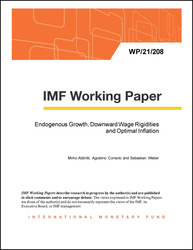
Endogenous Growth, Downward Wage Rigidities and Optimal Inflation
Endogenous Growth, Downward Wage Rigidities and Optimal Inflation
READ MORE...
Volume/Issue:
Volume 2021
Issue 208
Publication date: August 2021
ISBN: 9781513583983
$5.00
Add to Cart by clicking price of the language and format you'd like to purchase
Available Languages and Formats
| English |
Prices in red indicate formats that are not yet available but are forthcoming.
Topics covered in this book
This title contains information about the following subjects.
Click on a subject if you would like to see other titles with the same subjects.
Inflation , Labor , Economics- Macroeconomics , Money and Monetary Policy , Economics / General , NK model , inflation level , invariance hypothesis , target value , target carry welfare cost , Inflation targeting , Inflation , Wage rigidity , Wages , Wage adjustments , Global
Summary
Standard New Keynesian (NK) models feature an optimal inflation target well below two percent, limited welfare losses from business cycle fluctuations and long-term monetary neutrality. We develop a NK framework with labour market frictions, endogenous productivity and downward wage rigidity (DWR) which challenges these results. The model features a non-vertical long-run Phillips curve between inflation and unemployment and a trade-off between price distortions and output hysteresis that change the welfare-maximizing inflation level. For a plausible set of parameters, the optimal inflation target is in excess of two percent, a target value commonly used across central banks. Deviations from the optimal target carry welfare costs multiple times higher than in traditional NK models. The main reason is that endogenous growth and DWR generate asymmetric and hysteresis effects on unemployment and output. Price level targeting or a Taylor-rule responding to the unemployment rate can handle better the asymmetric and hysteresis effects in our model and deliver significant welfare gains. Our results are robust to the inclusion of the effective lower bound on the monetary policy interest rate.
Copyright © 2010 - 2025
Powered by:
AIDC



